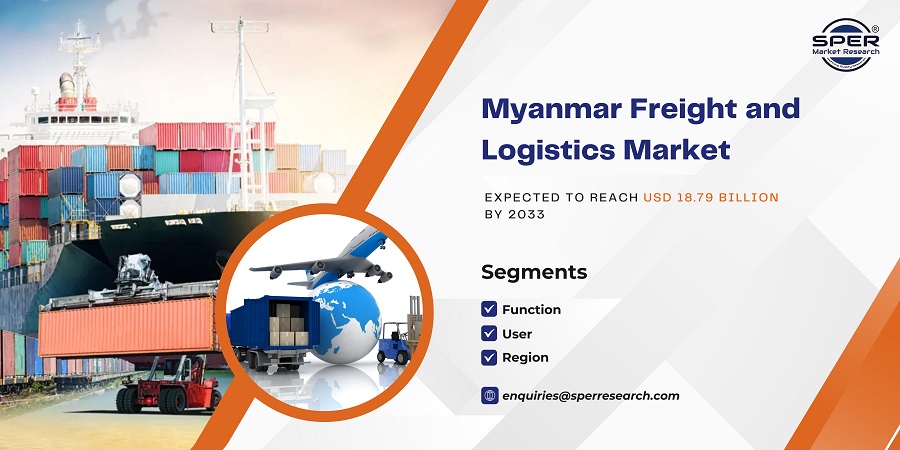Freight and logistics are critical components of the global supply chain because they allow products to be efficiently transferred from manufacturers to consumers. Logistics refers to the planning, coordination, and management of the entire transportation process, whereas freight refers to the actual things being transported. This intricate network includes ships, planes, trucks, and railroads, as well as freight forwarders, customs brokers, and warehouses. Order processing, inventory management, packing, labeling, and tracking are all part of the process. Freight and logistics operations must be swift and dependable in order for firms to meet consumer expectations, save money, and maximize stock.
According to SPER market research, ‘Myanmar Freight and Logistics Market Size- By Function, By End User – Regional Outlook, Competitive Strategies and Segment Forecast to 2033’ state that the Myanmar Freight and Logistics Market is predicted to reach USD 18.79 billion by 2033 with a CAGR of 11.20%.
There are several main drivers promoting the expansion of Myanmar’s freight and logistics business, which offers opportunities for expansion and development. Economic liberalization and increased foreign investment have encouraged businesses to establish themselves in the country, resulting in increased trade volumes and a greater demand for logistics services. Furthermore, Myanmar’s unique geographical location between South Asia and Southeast Asia places it as a key crossroads for regional trade and connectivity, reinforcing its relevance in transnational supply chains and logistics networks. The government’s focus on infrastructure development, such as ports, highways, and airports, has increased logistical capacity,
The freight and logistics market in Myanmar is facing a number of serious problems that are affecting its efficiency and growth potential. Infrastructure constraints, such as inadequate road networks, limited rail connectivity, and congested ports, inhibit the smooth movement of commodities both inside and beyond borders. The regulatory environment is complex, with frequent changes and bureaucratic red tape prompting logistics companies to be hesitant. Myanmar’s history of political insecurity and civil unrest can disrupt supply chains and logistics operations, disrupting trade and transportation. In Myanmar, the availability of qualified workers with expertise of logistics and supply chain management is a challenge, limiting the sector’s capacity
Request For Free Sample Report @ https://www.sperresearch.com/report-store/myanmar-freight-and-logistics-market.aspx?sample=1
The COVID-19 outbreak has wreaked havoc on Myanmar’s freight and transportation industries. Countries enacted lockdowns, travel bans, and social distancing measures as the virus spread, causing supply chain and commerce challenges. Myanmar’s freight and logistics industry was no exception, as it faced numerous obstacles throughout this time period. International border closures or limitations hampered commodity movement to and from Myanmar, causing delays and congestion at ports, airports, and land border crossings. As a result of the closure of physical retail locations and movement restrictions, customer behaviour shifted toward online purchase, increasing demand for last-mile delivery and warehousing services.
Geographically, Myanmar’s freight and logistics market had experienced rapid expansion and development. The country’s strategic location between South and Southeast Asia, as well as its growing infrastructure and increased commercial operations, have all contributed to the sector’s growth.
In the regional context, Myanmar’s logistics industry was critical in facilitating trade and transit within the country and throughout the region. Key cities such as Yangon, Mandalay, and Naypyidaw served as vital logistics hubs, connecting the country’s manufacturing centers with worldwide markets. Additionally, some of the market key players are Yamoto Holdings Co. Ltd, Advantis, Damco, Sojitz Logistics Corporation, Magnate Group Logistics Company Limited, KOSPA Limited, Others.
Myanmar Logistics and Transportation Market Key Segments Covered
The SPER Market Research report seeks to give market dynamics, demand, and supply forecasts for the years up to 2033. This report contains statistics on product type segment growth estimates and forecasts.
By Function: Based on the Function, Myanmar Freight and Logistics Market is segmented as; Freight Transport, Freight Forwarding, Warehousing, Value-added Services, Others.
By End User: Based on the End User, Myanmar Freight and Logistics Market is segmented as; Manufacturing and Automobile, Oil, Gas, Mining and Quarrying, Agriculture, Fishing and Forestry Construction, Distributive Trade, Others.
By Region: This research also includes data for Yangon, Mandalay, bago and Rest of Myanmar.
For More Information, refer to below link:-
Myanmar Logistics and Transportation Market Outlook
Related Reports:
Follow Us –
LinkedIn | Instagram | Facebook | Twitter
Contact Us:
Sara Lopes, Business Consultant – USA
SPER Market Research
+1-347-460-289974



